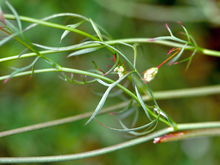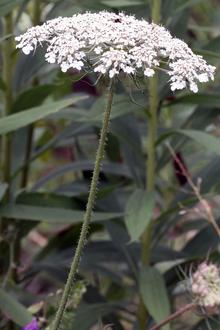Quick facts
Queen Anne's lace is an invasive species.
- Queen Anne’s lace is an invader of disturbed and newly restored areas where it can outcompete other species due to its faster maturation rate and size.
- Tends to decline as native grasses and forbs reestablish.
CAUTION: May cause phytophotodermatitis where sap touches the skin and is exposed to sunlight; wear long sleeves if handling. Also can easily be confused with the native, yet deadly, poison hemlock.
Queen Anne's lace should be reported. The Minnesota Department of Natural Resources provides detailed recommendations for reporting invasive species.
How to identify Queen Anne's lace
- Biennial herbaceous plant, one to four feet tall.
- Also known as wild carrot, Queen Anne’s lace smells like a carrot and is the ancestor of the garden carrot.
- Appears as rosette in its first year.
Stem
- Consists of one or several hairy hollow stems growing from one central stem, each with an umbrella-shaped flower cluster at the top.
Leaves
- Alternate, feathery and lacy leaves start immediately below the flower, increasing in size down the stem.
- They are pinnately divided.
Flowers
- Compound, tiny individual white flowers arranged in a flat-topped umbel, two to four inch diameter.
- The umbel becomes concave when reaching maturity.
- Often there’s one dark red or purple flower in the center of the umbel.
- Flowers bloom May through October.
Seeds
- Barbed, small, brown, oval, flat seeds with hooked spines promote dispersal by animals and wind.
- Seeds survive in the soil for one to two years.
- When the seed head dries it curls up in the fall and looks like a bird’s nest.
Roots
- Slender, woody taproot with carrot-like smell.
- More woody than domesticated garden carrots.
Reviewed in 2019




